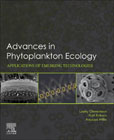
Advances in Phytoplankton Ecology: Applications of Emerging Technologies
Clementson, Lesley
Eriksen, Ruth
Willis, Anusuya
Phytoplankton ecology has developed from an understanding of taxonomy, species dynamics and functional roles, and species interactions with the surrounding environment. New and emerging technologies enable a paradigm shift in the ways we monitor and understand phytoplankton in a range of environments. Advances in Phytoplankton Ecology: Applications of Emerging Technologies is a practical guide to these new technologies and explores their application with case studies to show how recent advances have changed our understanding of phytoplankton ecology.Part one of this book explores how traditional taxonomy and species identification has changed, moving from morphological to molecular techniques. Part two explores the new technologies for remote and automatic monitoring and sensor technology and applications for management. Part three explores the explosion of omics techniques and their application in species identification, functional populations, trait characterization, interspecific interactions, and interaction with their environment.This book is an invaluable guide for marine and freshwater ecology researchers to how new technologies can enhance our understanding of ecology. Combines traditional techniques with new technologies and methods Explores the influence of new technology on our understanding of phytoplankton ecology Provides practical applications of each technique through case studies in each chapter INDICE: Introduction: Traditional ecology into the futureLesley A. Clementson, Ruth S. Eriksen and Anusuya WillisPart 1: Phytoplankton taxonomy (brief review/introduction)Ruth S. Eriksen 1.1 Cyanobacterial diversity and taxonomic uncertainty: polyphasic pathways to improved resolution Glenn B. McGregor and Barbara C. Sendall 1.2. Uses of molecular taxonomy in identifying phytoplankton communities from the Continuous Plankton Recorder Survey Rowena Stern, Declan Schroeder, Andrea Highfield, Manal Al-Kandari, Luigi Vezzulli and Anthony Richardson 1.3. Impact of molecular approaches on dinoflagellate taxonomy and systematics - Christopher J S.. Bolch 1.4. From molecules to ecosystem functioning: insight into new approaches to taxonomy to monitor harmful algae diversity in Chile. Jorge I. Mardones, Bernd Krock, Lara Marcus, Catharina Alves-de-Souza, Satoshi Nagai, Kyoko Yarimizu, Alejandro Clément, Nicole Correa, Sebastian Silva, Javier Paredes, and Peter Von DassowPart 2: Monitoring and sensing systems (brief review/introduction) Lesley A. Clementson 2.1. Integrating Imaging and Molecular Approaches to Assess Phytoplankton Diversity Lisa Campbell, Chetan Gaonkar and Darren W. Henrichs 2.2. Advances in in situ systems for phytoplankton research and monitoring Matthew C. Smith, Levente Bodrossy and Pascal Craw 2.3. Applications of satellite remote sensing technology to analysis of phytoplankton community structure on large scales Astrid Bracher, Robert J. W. Brewin, Áurea M. Ciotti, and Lesley A. Clementson, Takafumi Hirata, Tihomir Kostadinov, Colleen B. Mouw and Emanuele Organelli2.4. Modelling phytoplankton processes in multiple functional types Mark Baird, Stephanie Dutkiewicz, Anna Hickman, Mathieu Mongin, Monika Soja-Wozniak, Jennifer Skerratt, Karen Wild-Allen 2.5 Managing the societal uses of phytoplankton: Technology applications and needs Andrew D.L. StevenPart 3 Omics in aquatic ecology (brief review/introduction) Anusuya Willis 3.1. Current applications and technological advances in quantitative real time PCR (qPCR): A versatile tool for the study of phytoplankton ecology Kathryn J. Coyne, Yanfei Wang, Susanna A. Wood, Peter D. Countway and Sydney M. Greenlee 3.2. Phytoplankton diversity and ecology through the lens of high throughput sequencing technologies Adriana Lopes dos Santos, Catherine Gerikas Ribeiro, Denise Ong, Laurence Garczarek, Xiao Li Shi, Scott D. Nodder, Daniel Vaulot and Andres Guitierrez Rodrigues3.3 Comparative genomics for understanding intraspecific diversity Anusuya Willis, Jason N. Woodhouse, Brett A. Neilan and Michele A. Burford 3.4. Transcriptomic and metatranscriptomic approaches in phytoplankton: insights and advances Bethany C. Kolody , Matthew J. Harke, Sharon E. Hook and Andrew E. Allen 3.5. From Genes to Ecosystems: using molecular information from diatoms to understand ecological processes John A. Berges, Erica B. Young, Kimberlee Thamatrakon and Alison R. Taylor 3.6 Global marine phytoplankton revealed by the Tara Oceans expedition Flora Vincent, Federico M. Ibarbalz and Chris Bowler
- ISBN: 978-0-12-822861-6
- Editorial: Elsevier
- Encuadernacion: Rústica
- Páginas: 624
- Fecha Publicación: 10/12/2021
- Nº Volúmenes: 1
- Idioma: Inglés
